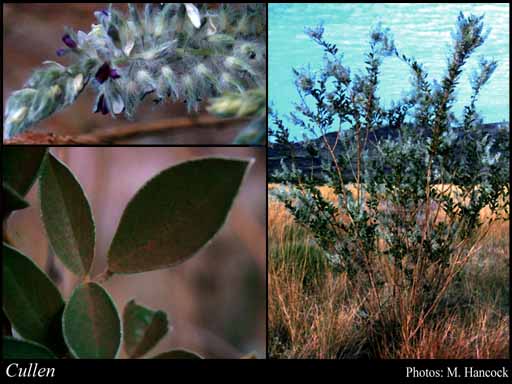- Reference
- Vorles.Churpfälz.Phys.-Öcon.Ges. 2:381 (1787)
- Name Status
- Current







Scientific Description
Family Papilionaceae. Psoraleae.
Sometimes included in Psoralea.
Habit and leaf form. Shrubs (or subshrubs), or herbs. The herbs perennial; plants with neither basal nor terminal concentrations of leaves; to 0.3–3 m high. Mesophytic, or xerophytic. Leaves small to medium-sized; alternate; spiral, or distichous; ‘herbaceous’, or leathery; not imbricate; petiolate. Petioles wingless. Leaves non-sheathing; not gland-dotted; compound; pulvinate; unifoliolate, or ternate, or pinnate, or palmate. Leaves when trifoliolate, pinnately trifoliolate, or palmately trifoliolate. Leaves when pinnate, imparipinnate. Leaflets 1, or 3, or 4, or 7 (1 or 3(–7)); not stipellate; pulvinate, or epulvinate; flat, or folded; without lateral lobes. Leaf blades dorsiventral. Leaves with stipules. Stipules intrapetiolar; adnate to the petiole; free of one another, or concrescent. Leaf blade margins minutely dentate (denticulate); prickly (rarely), or not prickly. Leaves without a persistent basal meristem. Leaf anatomy. Glandular hairs present (these sessile, black, orange, yellow or transclucent). Stem anatomy. Nodes tri-lacunar, or penta-lacunar. Secondary thickening developing from a conventional cambial ring.
Reproductive type, pollination. Fertile flowers hermaphrodite. Unisexual flowers absent. Plants hermaphrodite.
Inflorescence and flower features. Flowers aggregated in ‘inflorescences’; in racemes, or in spikes, or in umbels, or in panicles. Inflorescences compound (with 2 or 3(–12) flowers per node); axillary (mostly), or terminal and axillary. Flowers pedicellate; bracteate; ebracteolate; small to medium-sized; very irregular; zygomorphic; resupinate, or not resupinate. The floral asymmetry involving the perianth and involving the androecium. Flowers papilionaceous (imbricate-descending); 5 merous. Floral receptacle developing a gynophore, or with neither androphore nor gynophore. Free hypanthium present, or absent. Perianth with distinct calyx and corolla; 10; 2 -whorled; isomerous. Calyx present; 5; 1 -whorled; gamosepalous; 5 lobed. Calyx lobes markedly longer than the tube. Calyx imbricate, or valvate; exceeded by the corolla, or more or less equalling the corolla to exceeding the corolla (commonly); bilabiate (and usually with the median anterior lobe larger); non-fleshy; persistent; non-accrescent; with the median member anterior. Corolla present; 5; 1 -whorled; not appendiculate. Standard not appendaged. Corolla partially gamopetalous. 2 of the petals joined (the two ventral petals connivent to form the ‘keel’), or 4 of the petals joined (with the wings adherent to the keel). The joined petals anterior (or anterior and lateral). The wings of the corolla adherent to the keel, or free from the keel; not laterally spurred. Standard ‘normally’ developed; not sericeous (glabrous). Keel about equalling the wings (slightly incurved); not long-acuminate/beaked; neither coiled nor spiralled; not bent and beaked. Corolla imbricate (descending); pink, or purple, or violet, or blue; deciduous. Petals clawed. Androecial members definite in number. Androecium 10. Androecial sequence determinable, or not determinable. Androecial members free of the perianth; all equal, or markedly unequal; coherent (the filanents firming a tube below); 1 - adelphous, or 2 - adelphous (the tenth, posterior stamen sometimes free). The staminal tube free from the keel petals. Androecial members 1 -whorled (though diplostemonous). Androecium exclusively of fertile stamens. Stamens 10; all more or less similar in shape; diplostemonous; both opposite and alternating with the corolla members. Anthers separate from one another, or connivent; all alike; dorsifixed; versatile; dehiscing via pores, or dehiscing via longitudinal slits; latrorse, or introrse; tetrasporangiate. Gynoecium 1 carpelled. The pistil 1 celled. Carpels reduced in number relative to the perianth. Gynoecium monomerous; of one carpel; superior. Carpel stylate; apically stigmatic. Style (in-) curved. Style bearded via an apical tuft, or glabrous. Stigmatic tissue terminal. Carpel 1 ovuled. Placentation marginal, or basal. Ovary sessile to stipitate. Ovules pendulous to ascending; arillate, or non-arillate; anatropous, or campylotropous to amphitropous, or hemianatropous.
Fruit and seed features. Fruit 2.5–7 mm long; stipitate to sessile; non-fleshy; hairy, or not hairy; not spinose. The fruiting carpel indehiscent (verrucose); dubiously a legume, or an achene (the pericarp thin, adhering to the seed). Pods globose to somewhat elongated (oval); not triangular; not becoming inflated; terete; not constricted between the seeds; not transversely septate; wingless. Fruit 1 celled. Dispersal unit the fruit. Fruit 1 seeded. Seeds endospermic, or non-endospermic; not mucous; small; non-arillate. Cotyledons 2; accumbent. Embryo bent. Testa non-operculate. Micropyle zigzag, or not zigzag. Seedling. Germination phanerocotylar, or cryptocotylar.
Physiology, biochemistry. Nitrogen-fixing root nodules present. Aluminium accumulation not found. Photosynthetic pathway: C3.
Geography, cytology, number of species. Native of Australia and adventive. Endemic to Australia. 2n=22. A genus of about 35 species; 21 species in Western Australia.